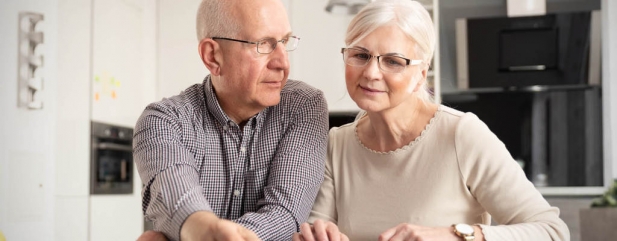Archived article
Please note that tax, investment, pension and ISA rules can change and the information and any views contained in this article may now be inaccurate.
How much money will I need in retirement?

It is very difficult to predict how much you’ll spend each year looking a decade ahead, let alone trying to predict what your annual spending will be in retirement. But it’s important to know how much you’re likely to spend, so you can make sure you’ve saved enough to meet those costs.
Many people tend to base their income expectations in retirement on a comparable sum to what they earned each year when they were employed, but for lots of people this will be a really ambitious sum to reach.

Generally, your costs should be lower in retirement, as you could have paid off your mortgage, your children should be financially independent and you won’t have to pay the costs of commuting, for example.
DOWNSIZING
You might also move to a smaller house, which is cheaper to maintain, or only need one car, rather than two. Conversely many people plan to spend their retirement going on lots of holidays, which can be a big cost, as well as socialising more or taking up pricier hobbies, such as golf.

To help people plan out how much we actually need in pension income, the Pension and Lifetime Savings Association (PLSA) has put together three scenarios for retirement and worked out the costs.
The options include different levels of holidays, spending on food and leisure activities, among others. They vary between a £15,700 a year cost for a couple or £10,200 for an individual, to £47,500 for a couple or £33,000 per person.
These figures increase if you’re living in London, where the cost of living is higher – for example the minimum level for a couple rises to £19,800 and the comfortable level for an individual rises to £36,300. Clearly everyone will spend money differently, but it’s a good guide to roughly how much you might need for the lifestyle you want.
Back of an envelope sums suggest an individual buying an annuity might need a pension pot of around £200,000 to achieve a £10,000 annual income – although most of us should be able to supplement our in-comings with the state pension.
Let’s look at each scenario:
MINIMUM
This is the base level case from the PLSA, and covers all of the basics while also leaving a little pot of money to have some fun with. It allows £38 a week for food and drink for a single person, which covers a food shop in Tesco, including some cheap beer or wine, and one takeaway plus one meal out a month, at an additional cost of £45.
All the scenarios assume you’re a homeowner, not a renter, and that you have paid off your mortgage, although they do allow money for household bills. The minimum scenario means you can buy contents insurance and can spend £150 a year on decorating or maintenance of your house, but it doesn’t allow for any gardening or cleaning. All scenarios allow for basic broadband at home, a TV and a Sky package and this minimum case also allows for a basic mobile phone per person on a £7.50 a month contract.
Transport is another big difference between the scenarios. This example assumes that you don’t have a car to run, and that you use your free bus pass and also have a rail card to get reduced fares, as well as allowing for £100 per person a year for train tickets, and £10 a week per household for taxis.
For clothing and personal care you’re allowed a £15 hair cut or £8 for men every month to six weeks, as well as £350 a year for clothes for women and £230 a year for men. Basic costs of dentists, new glasses etc are included for all scenarios.
Holidays are a big focus for many in retirement, and even the basic model allows for some trips. You can have one week-long trip in the UK a year on a coach package deal, as well as a long weekend in the UK, but with both going off peak, and £225 holiday spending money in total for the year for the couple.
Finally, £40 per couple a week is given for hobbies or social occasions, allowing for going to the cinema or swimming, for example.
MODERATE
This scenario is intended to give a touch more financial security and bit more luxury in places. The food and drink costs rise to £46 a week, accounting for slightly higher-end goods, but still from Tesco, including more expensive wine and beer. It also accounts for £75 a month for eating out or getting a takeaway.
For housing the costs allow for much more than the minimum: you can get building and contents insurance, pay for boiler servicing and insurance, and pay for a funeral plan. In addition you have £500 a year to spend on decorating or getting a handy-person in to fix things, but it doesn’t allow anything for major house renovations. You also have no budget for a gardener or cleaner. On top of this you can have a better smartphone, costing £16 a month per person.
In this scenario on top of the same allowance for train and taxis as the minimum case, car ownership is included. The example is that the car is three years old and is replaced every decade. The clothing budget is also bumped up to £750 a year per person, while hairdressing costs are increased to £45 every six weeks for women as well as £20 for beauty treatments.
Your holiday options are also upgraded and stretch to going abroad. The model allows for 10 days in the Mediterranean, but still outside of school holidays, in a three-star hotel, as well as a long weekend in the UK. Total spending money also increases to £475 per couple for both trips too.
You can spend more on hobbies and going out, with the budget increasing to £70 a week for a couple, meaning you can go to the theatre or take a day trip, for example.
COMFORTABLE
This example is intended to show more financial freedom but also allow for some luxuries in your retirement, as well as bit more day-to-day spending.
The food and drink costs increase further to £56 a week, which allows you to shop at Sainsbury’s rather than Tesco, although mainly buying own-brand goods. It also gives a much bigger budget for eating out: £100 per couple a week for meals out or takeaways, plus £100 a couple a month to take others out for a meal.
On top of what’s provided for in the moderate case, you get a higher budget of £900 for decorating costs or house maintenance, so doing a big project like redoing your kitchen or getting double-glazing could be possible after a few years of saving.
Also included is a gardener to do some work a couple of times a year and mow the lawn regularly and a cleaner to help two days a year with deep cleans, as well as a window cleaner every month. You can also have a top-of-the-range smartphone costing £28 a month per person.
For this example as a couple you’re allowed a more high-end car (the example is a Nissan Qashqai) that’s five years old but replaced every five years, in addition to a second, older, cheaper car that’s also replaced every five years. You train costs are bumped up to £200 a year per person.
The clothing budget is increased again to £1,500 a year for a woman and £1,000 for men, while hairdressing costs rise to £75 every six weeks.
Holidays get distinctly more luxurious in this scenario, with a two week trip to the Med in the summer, still not in school holidays, as well as a week in the sun in winter, to somewhere like the Canaries. Total holiday spending money increases to almost £1,000 in total for a couple a year. The social budget ramps up too, to £100 per couple a week, meaning that you could have a gym membership or belong to the local golf club, as well as have some outings.
In addition, you get a number of upgrades to your home life. So the cost of a second TV is accounted for, as well as a streaming service like Netflix on top of your Sky TV subscription, and a music service like Spotify is also included. Also £1,000 a year is included in the budget to spend on family members, so either for taking grandchildren out, contributing to a family holiday or saving up to give bigger gifts for things like weddings.
Important information:
These articles are provided by Shares magazine which is published by AJ Bell Media, a part of AJ Bell. Shares is not written by AJ Bell.
Shares is provided for your general information and use and is not a personal recommendation to invest. It is not intended to be relied upon by you in making or not making any investment decisions. The investments referred to in these articles will not be suitable for all investors. If in doubt please seek appropriate independent financial advice.
Investors acting on the information in these articles do so at their own risk and AJ Bell Media and its staff do not accept liability for losses suffered by investors as a result of their investment decisions.

 magazine
magazine








